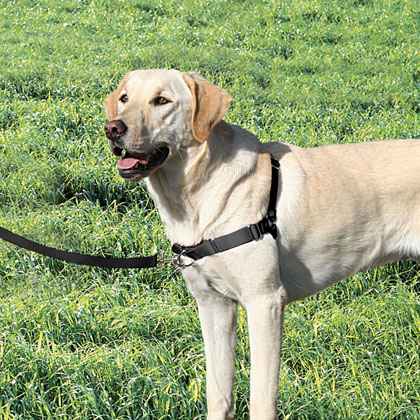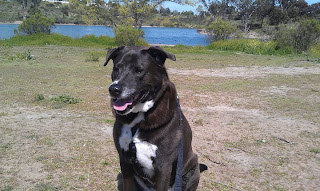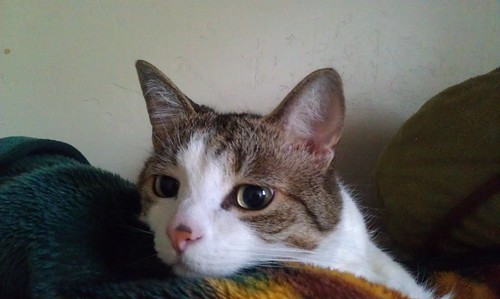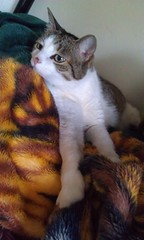B.B. is a wonderful dog. Affectionate, intelligent, and personable, he has been a great addition to our household. He has gently accepted the many foster puppies that came and went, and he is generally tolerant of the other pets. B.B. listens to commands, responds well to praise, and has never once damaged anything in the house while we are gone. He warns us when visitors approach the gate and we feel safe having him as our ally.
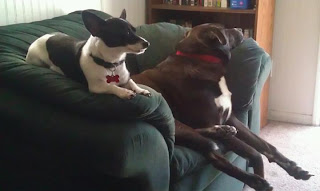 |
| B.B. with one of our fosters |
However, if there is one area where B.B. challenges us as dog owners, it is on the leash. When we brought him home from the
San Diego Humane Society, it appeared that he had never been walked on a leash before. He meandered back and forth, pulling like a Clydesdale and urinating on everything in sight (including himself). At home, he was obedient. He loved to accompany us on errands and chase a ball in the yard. But once on the leash, he was a holy terror racing through the streets with wild abandon.
Maybe, we thought, walking on a leash was not for him. It was also a physically painful experience for me! And of course, we did not expect him to exercise himself, even though we have a very large yard. We knew that, as an active Labrador, he would need thirty to sixty minutes of exercise time per day. So we tried the off-leash area at
Harry Griffen Park in La Mesa, which we found on the website
BringFido.com.
TIP: Dog exercise needs:
http://dogtime.com/exercise-needs.html
This was a dubious venture, since we knew that
dog parks are controversial. For some dogs, they are a great way to interact with other dogs and get plenty of exercise, especially if the dog's owner does not have a yard or is unable to walk their dog. However, some dogs, especially social climbers, may exhibit aggressive behavior towards other dogs under these circumstances. They may react when they see a dog which they perceive to be Alpha, and attempt to dominate that dog. Unfortunately, this turned out to be the case with B.B.
When we first entered the dog park, B.B. romped around with the other dogs, made the appropriate play moves, and seemed to be having a great time. However, as soon as he spied a dog larger than himself, he made a beeline for that dog and tried to climb on his back. If the other dog growled or snapped, B.B. would back away, but he kept coming back to pester that dog until we began to worry that he would anger the other dog enough to get bitten. We tried coming back to the dog park several times and the same thing happened: play nice until a larger dog comes along, then spend the entire time attempting to dominate that dog.
Moreover, when we brought B.B. home from the dog park, he began exhibiting social climbing behavior towards us. He attempted to initiate rough play, pawed us for attention, and started pushing us aside to rush through doorways ahead of us. Research on Alpha dog behavior alerted us that these were not good signs. B.B. was not a dog park dog; he needed more pack structure and a calmer social environment.
TIP:
Dog behavior: http://www.canismajor.com/dog/packdyn.html
Therefore, back to leash training. We were familiar with leash training, having taught our Dane to walk calmly on our left side. Back then, we used a wonderful dog training book by Brian Kilcommons:
However, B.B.'s impulsiveness proved to be an obstacle to teaching him to heel. We needed a strong leash to begin with, to avoid having our arms pulled out of their sockets. Not wanting to use a choke chain, we first tried some gentler options.

Our first choice was an adjustable harness. We thought this would at least enable us to hang on to B.B. while we worked through our training techniques. Although this helped keep us on our feet when B.B. spotted a squirrel, another dog, or identified an irresistible scent, he was still able to pull me down the street as if I weighed no more than a fly. And the harness presented two problems which we hadn't anticipated.
One is, B.B. could get out of the harness if it wasn't adjusted tightly. A very smart dog, he learned how to turn around and back himself out of it. If we tightened the harness, he was less likely to escape; however, the harness began chafing him under the armpits. And it didn't make him any more aware that he had a human in tow. As a
pet sitter and dog walker, it was quite frustrating that our own dog was outwitting us!
We did some research and found that harnesses can actually encourage dogs to pull harder. So we tried a harness that was designed to keep dogs from pulling. This one is called the Easy Walk Harness.
The Easy Walk Harness is a great idea for a dog that is not impulsive but just pulls a little hard on the leash. It could help prevent a disabled owner from being injured, and also causes less trauma than the traditional harness. It is designed to pull your dog to the side if they surge ahead, redirecting their attention towards you while you give them positive reinforcement for good walking behavior.
Unfortunately, B.B. was not a match for the Easy Walk Harness. He zig-zagged all over the place trying to get away from it, pawed at it and became tangled up in it. And the harness did not restrain him when he became overwhelmed by his impulsiveness. He seemed to have forgotten that he was to walk on our left side and heel, and our shoulder sockets were not happy.
Our Dane used to walk beautifully on the Gentle Leader. She heeled well but displayed exuberance when greeting people and other dogs, so we used the Gentle Leader as our safety device should she momentarily forget her leash training.
However, the Gentle Leader proved to be an enormous distraction for B.B. He pawed at it continuously, no matter how we we adjusted it. He completely ignored our training commands and started exhibiting some very annoying walk behavior: diving into bushes to try to rub his nose in the leaves, rubbing his face on our legs while we were walking, and trying to rub his nose on other people.
Perhaps the most alarming outcome of using the Gentle Leader was that B.B., when overcome by an impulse, threw all his muscles into getting whatever interested him. Dogs barking behind a fence were a major danger. He would rush suddenly towards the fence, causing the Gentle Leader to snap his head to the side quickly, and he would turn and try to back out of the collar forcefully, twitching and whining and bucking like a wild horse in the rodeo. We were very concerned that he would injure himself, but we were running out of ideas for training aids.
When there were few distractions, B.B. would heel and respond to positive reinforcement. However, the Labrador impulsiveness meant that we needed a training collar that would actually restrain him should something catch his attention, because at that point he was immune to voice commands. One day we were walking with the Gentle Leader and he spotted a loose dog. I sidestepped into the street and gave the "leave it" command. B.B. initially listened but changed his mind and doubled back to see the dog. He wrapped his leash around a telephone pole, tripped me with the leash and threw me into the street where I fell onto my back. A car whizzed by close to my head. Too close. And that was the end of the Gentle Leader.
With a heavy heart, we went back to the pet store in search of a choke chain. Although we were hoping to leash-train B.B. with
positive reinforcement techniques, we had to consider his safety and our safety during walks. So we had B.B. sit in the aisle and try on choke chains, hoping that an initial period of using corrections during the walk would help curb B.B.'s impulsiveness. However, it had been a long time since we had used a choke chain so we looked around for store personnel to aid us in finding the right amount of slack in the chain. What we found instead was a dog trainer.

The dog trainer informed us that the choke chain was hazardous to dogs. She said that it requires constant corrections to get the dog's attention, and that it can harm the trachea and cause trauma to the neck. She recommended a prong collar in addition to the positive reinforcement training techniques.
This is where we balked. There was no way that we were putting this medieval-looking device on our B.B. I had seen people walking dogs on this and always thought, "why don't they just train their dog?" It seemed to me this was the lazy dog owner's answer to dog training. And it looked like it could possibly harm a dog. We went home and did some research.
Not surprisingly, it turns out that the dog trainer was right about the choke chains. Many studies have shown that they cause injuries to dogs. However, we read several articles about the safety of the prong collar, especially considered in comparison to choke chains. This was surprising, since they really do look harsh.
We went back to the store and tried one on B.B. We also asked the trainer how it works and how we should work it into our positive training techniques. So we set out to our regular walking place at
Lake Murray and tried it out, with the Gentle Leader in our pocket for back-up.
The prong collar hung slightly loose on B.B.'s neck and we started off in our normal fashion, with B.B. on my left and my pocket full of training treats. We use four commands at the lake. Three are for B.B. and one is for other dog owners:
"Heel," means "walk on my left at my pace."
"Leave it," means, "stop paying attention to that distraction."
"What a good dog!" is used for good walking behavior.
"Pull your dog back, please," is what we say to dog owners on the other side of the walkway, who are not paying attention to their dog. Often these are people with
retractable leashes who give their dog a lot of slack and let them wander out into the middle of the road to greet whomever or whatever they please. We are not a fan of retractable leashes, not only because they can cause severe injuries to humans, but because they do not allow a dog owner to adequately control their dog should danger appear.
We have taught B.B. the "leave it" command and use it as soon as he seems to be intrigued by another dog passing by. At first, we had to "sit" and allow other dogs to pass, but now B.B. resists the distraction as long as we pay close attention to his reactions and keep praising him when he ignores other dogs. However, when a dog owner lets their dog meander into our path, B.B. is overcome by the impulse to dart out and greet the dog. This is where we were hoping (although not too optimistically) that the prong collar would help correct that behavior. We were pleasantly surprised and relieved.
B.B. walked nicely to my left on the walk, paying attention to my voice and overcoming the urge to chase distractions. I never pulled on the prong collar once. Then a dog owner came walking in the opposite direction with a Min Pin on a retractable leash. If you have ever had a Min Pin, you know that they are born with their own leather studded jackets. They are small and do not realize it. Resembling a chihuahua, they have the confidence of a Doberman. They are not a good choice for a retractable leash.

When the Min Pin saw B.B., he charged towards him snarling and barking. B.B. immediately darted sideways to meet the dog. I said, "leave it"; the prong collar made a "clink" sound and pinched his neck; B.B. did an about-face and came back to my side. It happened so quickly that I barely registered what had happened. On any of the other collars, I would have had to stop, stand on the leash, and take B.B.'s collar in my hand to restrain him. But the prong collar surprised him, and with the "leave it" command, something seemed to have clicked in his brain. I praised him and handed him a treat while the Min Pin owner dragged her dog forward by the collar, cursing and yelling at it.
I never pulled on the collar; it naturally corrected him when he darted out suddenly from my side. I saw what the dog trainer meant about the prong collar administering its own correction. And for a dog that walks nicely MOST of the time but occasionally is overcome by impulse, it seems like a great complement to positive reinforcement. However, for a dog that pulls constantly, I might be concerned that the prong collar could result in repeated pain to the dog. And it certainly should not be used as a substitute for leash training.
Every dog is different. Some dogs without impulsive tendencies may walk very well on a traditional collar or harness. Different breeds have different training challenges, and some techniques and tools are fine for smaller dogs but not appropriate for larger breeds like B.B. Hopefully dog owners who have leash-training problems will consult a trainer for help in deciding on the best training tools to be used with positive reinforcement. It took us a lot of searching, but now our walks are happy and terror-free.

















